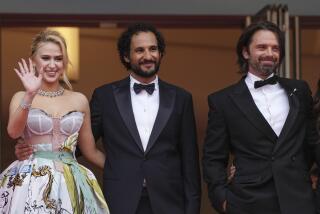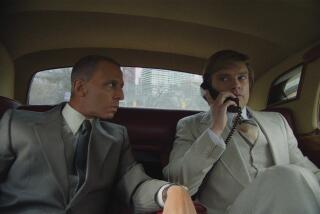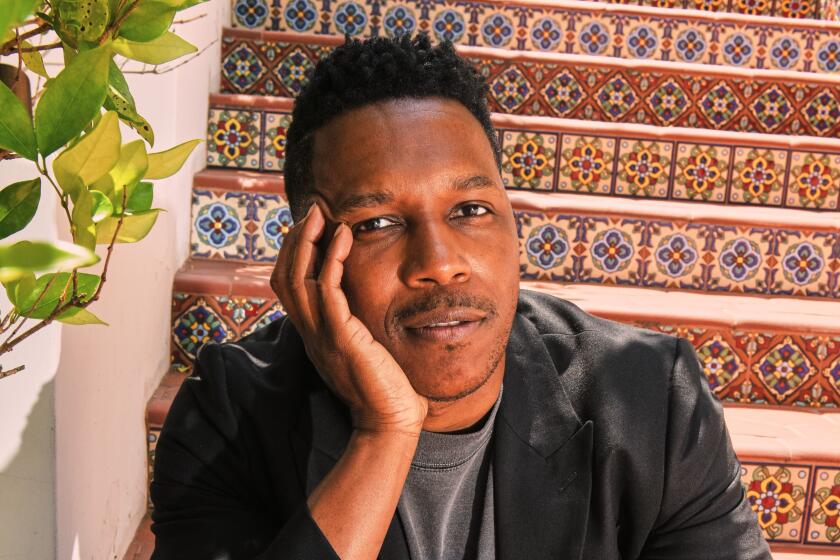Good Theater Blooms Mostly Out of Town
Was there good theater in Southern California this year?
You bet. Where was it? Mostly out of town. Where did it play? Mostly in larger theaters. Does this mean anything? Only that, as always, the rule in theater is that there is no rule, the trend that there is no trend and that the territory can be any territory.
Topping this writer’s personal list of shows reviewed and admired this year are “The Crucible” at Costa Mesa’s South Coast Repertory; “The Fool Show” at the La Jolla Playhouse; “The Voice of the Prairie,” “Tea” and “Coriolanus” at the San Diego Old Globe (this has been an Old Globe year); “Breaking the Silence” and “Born Yesterday” at the Pasadena Playhouse (this was also a Pasadena Playhouse year).
So where’s Los Angeles in all this? Close to the top, with such notable runners-up as the Los Angeles Theatre Center’s fascinating thriller “The House of Correction”; the light but superbly crafted “Frankie & Johnny in the Clair de Lune” at the Mark Taper and David Rabe’s rambling but remarkable “Hurlyburly” at the Westwood Playhouse through Jan. 15.
Martin Benson’s staging of “The Crucible” at South Coast sticks in the mind because of its meticulous devotion to playwright Arthur Miller’s intent.
Miller’s play is about responsibility and individual conscience, dressed up as a passionate account of the Salem witch-hunt trials of 1692. Aside from the benefit of the director’s almost invisible hand and the splendid work of a well-chosen cast, the play was exponentially strengthened at South Coast by Susan Tuohy’s design: semi-abstract planes in pale grays and soaring pin-stripes that reflected the fatal sternness of the lives within.
It is the same kind of expansion on a central idea that created the excitement of Stephen Poliakoff’s “Breaking the Silence.” As the title suggests, its premise is breakthrough: unshackling personal and political bonds, and breaking through literal as well as philosophical frontiers.
At the Pasadena Playhouse it wasn’t just a matter of formidable performances by Ken Ruta and Kendis Chappell in the leading roles. As with the “The Crucible,” there was a spectacular design by Deborah Raymond and Dorian Vernacchio showing the ragged interior of a once-opulent railroad car (emblematic of this family’s fall from grace) that became the author’s silent partner.
At play’s end, the car was sent hurtling like a missile over an imaginary border into the so-called free world--the ultimate breakthrough. Thus in a rare fusion of text and context--the physical propulsion of the car and the recalcitrant screams of its occupants--an indelible final image was created that clinched the play.
Nothing like this was true of the Old Globe’s “Coriolanus,” which achieved similar ends through more external means. Director John Hirsch updated Shakespeare’s study of power and megalomania leaning heavily on images of Oliver North, yards of chain link fence, smoke, bombs, cannon and colloquialisms. Spectacular and explosive were the words for it. Exploitative might have been too, except that Hirsch, like Benson, never lost sight of the play.
A far more subtle enconium is needed for the two other startling but more lyrical Old Globe shows: John Olive’s “Voice of the Prairie,” a small play with a big heart that paid homage to the pioneering days of radio, and Velina Hasu Houston’s “Tea,” a skillfull and poetic dissection of cultural violation.
“Voice,” which tracked the birth of radio (1895-1923) through the freight car adventures of a blind girl and her companion, and later of that grown-up companion and the man who pushed him into broadcasting, is an inspired, giddy celebration of the word.
Olive wrote in a program note that he “wanted to explore the way a storyteller transforms the past, the way he takes liberties with events--lies, in other words--to create a more vivid truth in the present.” This perfect example of fiction informing reality was vividly and lovingly brought to life at the Globe’s Carter Centre Stage by William Utay, Lynne Griffin and Sean Gregory Sullivan. Tom Bullard directed, magically.
Where the lyricism of “Voice” was muscular, that of “Tea” was diaphanous, but it performed the same task of informing the general through the particular. Here, four women, Japanese war brides now Americanized, reconstitute their lives as they perform a traditional tea ceremony over the death of a fifth one. Houston’s play is all talk--among the living and the dead--but incisive, revealing talk that shows the heavy cost of surrendering one’s culture for little in return. It’s an exquisite and elegant little play.
Elegance was not part of Geoff Hoyle’s “The Fool Show” at La Jolla. The title tells you that. But polish, cleverness, imagination and a sharp sense of the ironic were. Hoyle’s piece, created and performed by him, was--is--a model of Commedia dell’Arte foolishness, sometimes traditional, sometimes adapted to modern themes. What one admired here was the dedication to a demanding form that’s rarely seen and mostly undervalued. Hoyle is thinking of bringing the show to Los Angeles early in 1989. We can only hope.
Finally, a word about Garson Kanin’s “Born Yesterday.” The success of this Pasadena Playhouse revival rested on one major performance: that of David Schramm as the uncouth Harry Brock. It reinforced what we already knew: that this is no small play.
And there it is. Not that there wasn’t any good work in town, but that there wasn’t enough of it. Among plays seen and not forgotten, count above all Carole Shorenstein Hays’ compelling production (in association with the Yale Repertory Theatre) of August Wilson’s heartbreaking “Fences” at the Doolittle. In a busy but lackluster year for black theater locally, it did much to restore the faith.
Count also the Pasadena Playhouse production (again) of Jules Feiffer’s acidulous “Carnal Knowledge” and its twin stagings of “Jacques Brel Is . . . “ and “Lies and Legends: the Musical Stories of Harry Chapin.” (The burnished “Lies and Legends,” which moved to the Canon Theater after its hit Playhouse run, has found it hard to sustain unsubscribed audiences. If you haven’t seen this show, the time is now. It closes Jan. 1).
The smaller theaters of Los Angeles, in the shadow of an ongoing dispute with Actors Equity Assn., seemed mostly to hit new lows. But there were exceptions. Chief among them Neon Art’s revival of Marsha Norman’s “Getting Out” at the Burbage and Jeff Seymour’s staging of Rafael Lima’s “El Salvador” at the Gnu. Also fine was the Actors Gang’s satirical “Carnage” and Dennis Erdman’s staging of “How the Other Half Loves” running at the Tiffany until Jan. 1.
But there were also such bizarre undertakings as “Contact High” (a clumsy say-no-to-drugs injunction masquerading as theater) or “The Last Hunt” (a lavishly produced play that couldn’t disguise its emptiness) or “Grand Junction” a strangely constructed oddity neither grand nor conjoining.
To be great, after all, theater must be a collision of genius and judgment. How often can one get them to hit head-on?
More to Read
The biggest entertainment stories
Get our big stories about Hollywood, film, television, music, arts, culture and more right in your inbox as soon as they publish.
You may occasionally receive promotional content from the Los Angeles Times.






